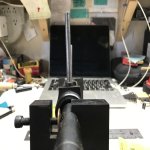I have used PVC split pipe (the grey thinner pipe of the correct diameter for the bbl) as a sleeve (plus rosin) around the bbl in a vise like the one in the above picture.
I used a long torque bar with a pipe as a snipe on an old M98 action (I use an inner action wrench). When that bbl let go I thought it was a gunshot or something broke the crack was so loud, but it finally released.
That particular tight bbl was during winter and I put it outside at -30 and then tried it, after giving the receiver a bit of heat from a propane torch to try and get a differential expansion going...it may have helped.
In my view, the metal spacers that fit exactly is of course the best way to go if you can make them.
Your vice's design does not contact enough metal of the bbl. If you can make a spacer that fits the V of the block and fits tightly around the bbl shank, you have fighting chance.
I used a long torque bar with a pipe as a snipe on an old M98 action (I use an inner action wrench). When that bbl let go I thought it was a gunshot or something broke the crack was so loud, but it finally released.
That particular tight bbl was during winter and I put it outside at -30 and then tried it, after giving the receiver a bit of heat from a propane torch to try and get a differential expansion going...it may have helped.
In my view, the metal spacers that fit exactly is of course the best way to go if you can make them.
Your vice's design does not contact enough metal of the bbl. If you can make a spacer that fits the V of the block and fits tightly around the bbl shank, you have fighting chance.
Last edited:








































































